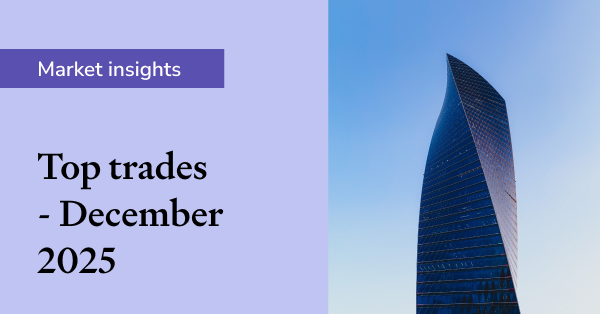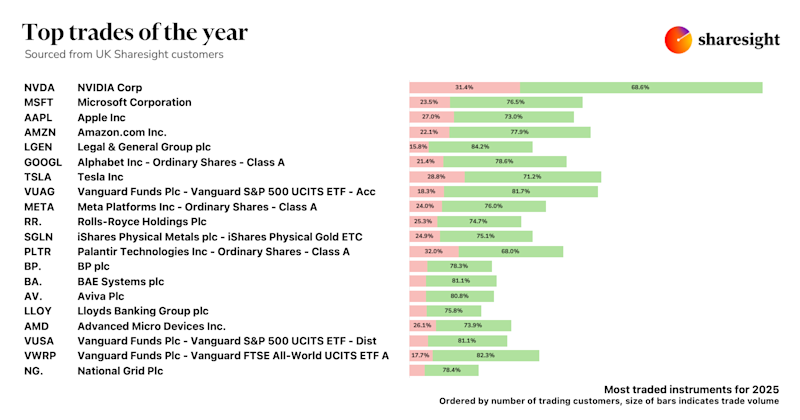8 tips to get your portfolio on track today
Consumer culture demands that certain times of the year are the time to buy specific things we need want. This relentless conditioning by retailers isn’t unique to one country.
Australians buy cars at EOFY and the Brits queue up for clothes on Boxing Day. Growing up in the States, I recall an endless stream of commercials for President’s Day mattress sales (bizarre, but true). Back then "zero money down and no payments for 18 months" was too complex a financial concept for a kid to grasp. Thirty years later I’ve come to realise it’s a dubious technique to encourage people to finance things they can’t afford.
What if we looked at these annual milestones differently? What if we maximised the money we save rather than justifying ways to spend it?
In Australia alone, 60% of adults own an investment according to the ASX. Of those 11M people, almost a third own shares directly. But how effectively has this money been put to work?
Getting your investment portfolio on the right track today creates an outsized impact on the gains you’ll realise in the future.
Even though Australia has a high rate of per capita investment, I suspect a good portion of it is poorly managed.
While the superannuation system mandates that people invest, it also creates a lazy, overpriced marketplace. A self-managed superannuation fund (SMSF) can be an investor’s best friend, but how to explain that over 26% of SMSF funds sit in cash, with another 30% dangerously overweight local shares?
Here are eight principles to get your portfolio on the right track:

1 - Confirm the value of your assets
If I asked you what your online brokerage account plus superannuation plus employee shares are worth, could you give me an accurate figure?
Treating your investments like a savings account is a mistake because even a healthy, growing balance might be a red herring.
A singular balance figure can be elusive due to the complex data plumbing behind the financial services industry, but if you don't know what you're working with, chances are you've already designated this to the too hard basket.
If you’re already tracking your holdings using Sharesight, you can cross this item off the list. Otherwise follow our guide on how to get set up your share portfolio. You only need the most basic of information to get started. An accurate opening balance is the first step towards becoming a successful investor.
2 - Calculate the performance of your portfolio
Do you remember doing compound interest calculations manually in economics class? Not fun. Calculating the true performance of an investment is really hard, let alone for an entire portfolio. While price to price calculations are simple, and charting tools ubiquitous, annualising them to add real-life context and to compare to alternative options is difficult.
If you’re tracking your portfolio in a spreadsheet, I guarantee you’ve made an error. Even if you do hold a CFA degree, you’re ignoring one of the most basic principles: the time value of money.
Unfortunately if you’re relying on your broker for this information, you’re not much better off. It’s important to understand why your broker’s performance numbers are useless.
Dividends add yet another level of complexity. Last year the ASX 200 generated almost 7% in dividend income. How do you track the dividend impact on your return, or if you’ve opted in to a dividend reinvestment plan?
And while it might be fun to debate its market impact, Amazon’s acquisition of Whole Foods won’t fit neatly in cell ‘Sheet2!Q17’ in your precious Excel spreadsheet. That’s because accounting for corporate actions is not something that lends itself well to manual record-keeping. This was made all too clear to me recently when a corporate action seriously tripped me up.
As you can see, manually tracking portfolio performance is tricky and time-consuming. Better to outsource it to a purpose-built product and focus on investment ideas instead.
3 - Consider what else you could have done with your money
Everybody wants to beat the benchmark. That’s a given. But to fully embrace benchmarking is to honestly evaluate opportunity cost and use it to inform your investing decisions.
The market is on an eight year bull run. It won’t last. This demands that you keep a close eye on your performance and consider a plan B. You might have a defensive portfolio in mind, or look to an index to weather a bear market.

The popularity of ETFs, for example, means you can actually invest in the benchmark, or any combination of benchmarks for that matter. The choice between active and passive investing is not binary. Savvy investors are using ETFs to get exposure to niche asset classes and run a “core/satellite” approach. And from there, portfolio benchmarking provides a true apples-to-apples comparison.
4 - Understand the true drivers of your performance
Was it the market as a whole that contributed to your gains, or a specific sector? Can you point the smart investment decisions you made, or are you just a boat on a rising tide?
The S&P 500 and the ASX 200 both returned about 18% over the past 12 months -- terrific results, but due to different phenomena.
For the S&P 500, tech companies have been on an absolute tear (until recently) and now comprise over 10% of the index’s market cap. The “FAANGs” (Facebook, Apple, Amazon, Netflix, and Google) explain much of the US market’s strong performance.

In Australia, bank shares and traditional financial services companies generated most of the the local index’s performance. Macquarie, NAB, ANZ, IOOF, and BT are all up over 30% in the past year, including dividends. Even better were some of the resource companies, with South32 and Fortescue up over 60%.
One way to help decipher your return is by applying Factset-powered groupings to your portfolio. If you want more flexibility, create your own investment categories using custom groups.
Once your portfolio matches your worldview, you’ll want to decompose your return profile. Here’s how I do this with my own portfolio.
5 - Determine how much you’re paying to invest
Fees are a necessary evil for all investors. Our research shows that a self-directed investor may sacrifice as much as 20% of their total return to fees every year. If you’re paying for advice and relying on expensive platforms, that jumps to 50% of your take home gains!
Once you’ve connected your online broker to Sharesight, we’ll automatically track the fees you pay each time you trade. Once you begin treating Shareight as your investing source of truth, it’s easy to switch to a low-cost broker like our partner CMC Stockbroking.
If you prefer professional management, the range of ETFs is growing rapidly. These are far cheaper than managed funds, and you can find an ETF proxy for most fund strategies.
A self-directed investor may sacrifice as much as 20% of their total return to fees every year. If you’re paying for advice and relying on expensive platforms, that jumps to 50% of your take home gains!
If you’re keen to use managed funds, check out ASX mFund or uXchange. These offer ways to cut-down on the transaction and administration costs associated with unlisted funds. Remember to research the manager’s fee (ICR), however, as Australia has some of the most expensive managed funds in the world.
6 - Keep an eye on interest rates
I’ve never experienced a high interest rate environment in my adult life, which means I’m not prepared for what rising rates will do to my portfolio. It also means that I’ve never paid too much attention to bonds, fixed interest, or term deposits because their yield has always been so poor.
History tells us that rates have to go up eventually. Where did all the money go that central banks printed post GFC? Interest rates should have a significant impact on share prices -- especially bank shares due to their dependency on the housing market.
I subscribe to Grant’s Interest Rate Observer and keep an eye on the research that PIMCO, a well-respected fixed income fund manager publishes.
7 - Listen to the ideas of others
People overexpose their portfolios to industries they know (i.e. work in) and suffer from home country bias. My portfolio, whilst minimally exposed to Australia, is certainly overweight in technology stocks because my wife and I both work in the industry.
I subscribe to Morningstar’s US and Australian websites. While their value-based model doesn’t produce many buy recommendations in a bull market, their fair value metrics and economic moat scoring are still useful for assessing companies on a holistic, long-term basis. Plus, they have loads of analytics on funds and ETFs.
An ETFs that tracks Morningstar’s “Wide Moat” stocks kept pace with the S&P 500 in the past year, but has returned 24% annualised since it launched in late 2007.
I also pay for Motley Fool in the US and Australia. They do have a particular marketing style, but their underlying stock recommendations are insightful, high conviction, and transparent. They focus relentlessly on ideas, which means their analysts are always on the hunt in any market environment.
I’ve built Motley Fool’s Dividend Investor portfolio in Sharesight. Annualised, over three years their picks have returned 12% compared to the ASX 200’s 8%, including dividends.

Their pick of Australian Pharmaceutical Industries (API) generated a 137% annualised return, while G8 Education yielded a whopping 11.5% of dividend income (they’ve since recommended selling these positions).
Some of the most respected fund managers publish their own research as well. If you’re curious about a local strategy or an overseas market, use Morningstar to find out who the best managers are and check out their websites. Most will have a “News & Insights” section.
Platinum produces some of Australia’s best commentary while Oakmark, based on the US publishes great insights -- they were recently named the international equity manager of the year by Morningstar.
It also pays to read up on macro investment themes and policy. Firstlinks produces a weekly newsletter that is packed with terrific content.
8 - Tend your portfolio like a gardener
Finally, take a long-term approach. Setup your portfolio to succeed based on what will happen in the future and be patient. Think about how much time you’re realistically willing to spend managing your investments. “Analysis paralysis” and too much turnover will both kill your return.

Take the time to do your research and stay organised as your dividends tumble in. Set price alerts in advance and think hard about when to take money out of the market. Even a losing investment is not a total waste -- if you’re on top of it you can apply the capital losses to your tax bill.
FURTHER READING

Sharesight users' top trades – December 2025
Welcome to the December 2025 edition of Sharesight’s monthly trading snapshot, where we look at the top buy and sell trades by Sharesight users over the month.

Top trades by UK Sharesight users in 2025
Welcome to the 2025 edition of our UK trading snapshot, where dive into this year’s top trades by the Sharesight userbase.

Top trades by global Sharesight users in 2025
Welcome to the 2025 edition of our global trading snapshot, where we dive into this year’s top trades by Sharesight users around the world.